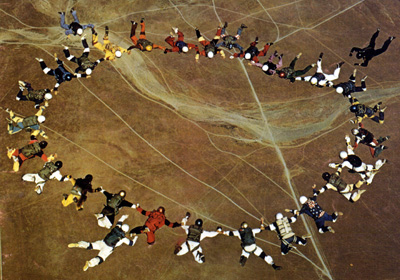Featured Exhibits
Sign up for the Newsletter
Advertise on ParachuteHistory.com
Disclaimer
Privacy Policy
About
27-way Star

Photo by Ray Cottingham
- Al Krueger
- Bud Krueger
- Jim Wallace
- Rick Taylor
- Jeff Fisher
- Bob Westover
- Patty Wickliffe
- Dave Wilds
- Jack Miles
- Dan French
- Jerry Kinley
- Ron Delmazzo
- John Donovan
- Bob Feuling
- Don Henderson
- Rich Picirrilli
- Bill Boles
- Ron Haun
- Chuck Wickliffe
- Ralph Johnson
- Marco Straziota
- Hank Asciutto
- Steve Fielding
- Dennis Treppanier
- Hal Hurley
- Warren Frazier
- Leo Orlowski
- Roger Kersey
- Mitch Poteet
- Alan Babich
Photographers
Ray Cottingham
Mike Jenkins
Larger stars required larger aircraft or more of the smaller aircraft. The primary aircraft at most DZs were Twin Beeches or Cessnas. There were a few DC-3s around. Turbines were unheard of at a DZ back then.
Mitch Poteet organized 30-way attempts for Sept. 8-9, 1973 at Elsinore. They planned to do 4 jumps from a fleet of 3 Beeches.
Poteet gave a briefing for the group: "The 10-way base would be built by the jumpers in the lead Beech. The photographers would be first out from each of the trail Beeches (floaters were not used), followed by groups of five. The jumpers in the first group of five from each Beech would spread themselves evenly around the near half of the 10-way star. They would enter as soon as their sector was clear. They were careful not to interfere with the build of the 10-way base. The second group of five from each Beech was to follow the jumper in the first group of five. Each jumper was to wait for the people in front of them to dock, rather than race by someone to beat them to the formation. Soft horizontal approaches were preferred to a hard and steep approach."
After the briefing it was learned that one of the originally scheduled Beeches did not show. The group used an 8 place Beech and C-180 instead. The 8-place Beech was lead and the C-180 was second left trail. The base 10-way was the 8 jumpers in the lead Beech and the first jumper, after the photographer, in each of the trail Beeches.
The first jump did not go well. It built to about 10 or 12 before funneling.
On the second jump, the 8-place Beech was moved over to the first left trail position. All of the jumpers in the base were exiting from the lead Beech. This dive did not fare well either. It funneled around a 12-way because of a hard, fast and steep dock.
Only two jumps were done on Saturday. The group had a late start waiting for clouds to burn off.
 Parachuting:The Skydiver's Handbook
Parachuting:The Skydiver's Handbook
For the third jump for the group, another Beech had been secured. Spike Yarder flew his Beech over to Elsinore from Van Nuys. Poteet reemphasized the need for soft horizontal approaches in order to get the large star to build.
The jumpers boarded the aircraft and fly to altitude for another attempt. This time things went very well. The star built quickly and smoothly. Jumpers demonstrated that the soft, horizontal approach is the way to build the formation. The star grew until near break-off altitude. Then a grip was lost, with 3 jumpers poised to dock. It was the largest star built to date: a 27-way. Two jumpers, Steve Fielding and Mike Jenkins had reserve rides on this record jump.
The group repacks and prepares for the fourth attempt. On this dive, the formation builds quickly, then permutated into teardrop and heart shaped formations. The tension was great and only fantastic flying kept it together. It only built to 24 when altitude ran out.
Several things were different in 1973. Floaters were not used. People recognized 'largest' formations built even if some of the jumpers on the jump did not dock. Some jumpers had piggyback rigs. Some still had chest mounted reserves. Beeches were crowded and took a great deal of skill to exit without slamming into the side of a narrow doorway.
[Products] | [Services]
[Join Our Mailing List] | [Advertise on ParachuteHistory.com]
[ ]
[Disclaimer] | [Privacy Policy] | [About]